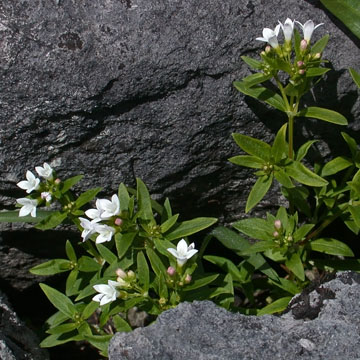

Houstonia longifolia - (image 1 of 4)
Taxonomy
Family: Rubiaceae
Habitat
Dry rocky, sandy, or thin soil.
Associates
Distribution
ME to Ontario and Saskatchewan, south to SC, MS, and AR.
Morphology
Herbaceous perennial from a fibrous-rooted base; stems numerous, simple or branches above, 10-25 cm, glabrous or finely hairy, especially at the nodes; leaves sessile, broadly linear to narrowly oblong, 1-3 cm long and 2-5 mm wide, narrowed to the base, glabrous or nearly so, 1-nerved; flowers on short-pedicels, numerous in loose or crowded terminal cymes, heterostylic; sepals lance-linear, 1-2 mm, in fruit equaling or exceeding the capsule; corolla purplish to white, hairy within, funnelform, 5.5-9 mm; corolla lobes half as long as the tube; stamens included or barely exserted; fruit globose or depressed-globose, half-inferior, 2.5-3.5 mm.
Notes
Flowers late May to Aug
Wetland indicator: NA
This species is variable and has been split into other species based on differences in leaf width, internode length, and pedicel length. The last image is of a plant found in Virginia that may represent what has been called H. tenuifolia, though the pedicels and internodes do not seem long enough. The other images are from an alvar in upstate NY.
Late in the season H. longifolia produces an abundance of slender basal leaves. It is easily transplanted or divided, preferring a loose, well-drained soil.
References
Gleason, Henry A.
and A. Cronquist. 1991. Manual of Vascular Plants of Northeastern United States
and Adjacent Canada. Second Ed.
The New York Botanical Garden. Bronx, NY
|
Michael Hough © 2018 |